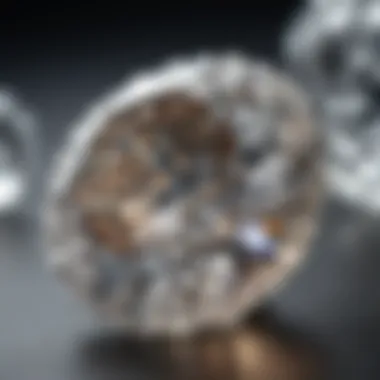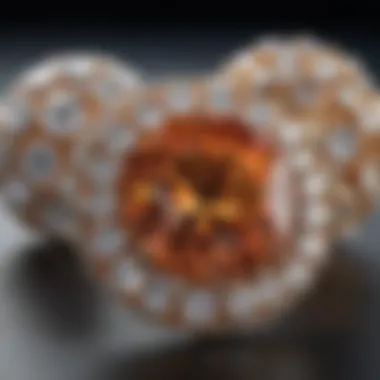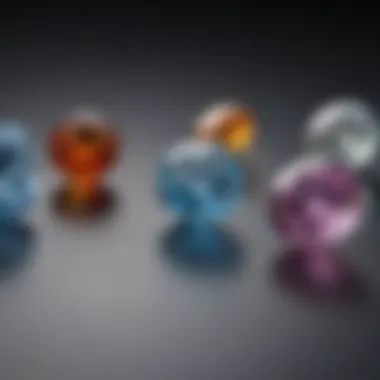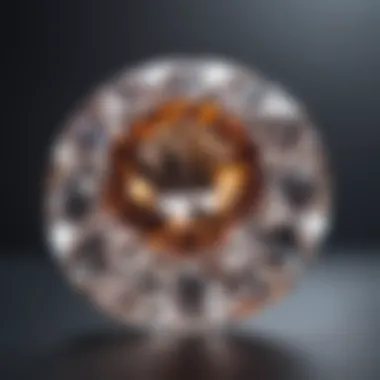Understanding Cubic Zirconia: Properties and Comparisons


Overview of Gemstones and Minerals
Gemstones and minerals have intrigued humanity for centuries. Their natural beauty, rarity, and the stories surrounding their origin contribute to their appeal. Understanding these elements provides insight into their significance in various aspects of life and culture.
History of Gemstone and Mineral Use
Throughout history, gemstones have played pivotal roles. From ancient civilizations to modern society, these stones were treasured for their beauty and supposed powers. Ancient Egyptians adorned themselves with turquoise and lapis lazuli, believing these stones offered protection and healing. During the Renaissance, diamonds emerged as status symbols, often linked with royalty. The appreciation for gemstones spans cultures, showcasing their enduring appeal.
Significance in Culture and Society
Gemstones and minerals are not only decorative objects; they embody cultural meanings. They frequently symbolize love, fidelity, and power. For example, rubies represent passion, while sapphires are often linked to trust and wisdom. In contemporary culture, engagement rings featuring diamonds represent commitment. This blend of beauty and symbolism underlines their lasting place in human society.
Exploration of Cubic Zirconia
Cubic zirconia stands out as a significant material among gemstones. Developed in the 1970s, it offers a cost-effective alternative to diamonds. Its resemblance to diamond, along with versatility, leads to its widespread use in jewelry.
Cubic zirconia is synthetic, yet it possesses a sophistication that often befuddles its observers.
Culmination
The examination of gemstones, particularly cubic zirconia, illustrates the multifaceted relationships between humans and these natural treasures. This journey through the history and meaning of gemstones sets the stage for understanding cubic zirconia's characteristics and applications in depth.
Preamble to Cubic Zirconia
Cubic zirconia, often referred to as CZ, is a synthetic gemstone that mimics the appearance of diamonds. Its introduction to the market has transformed the landscape of jewelry and gemstone collection. Unlike natural gemstones, cubic zirconia offers several benefits, such as affordability, durability, and a wide range of color options.
This section aims to demystify cubic zirconia for gemstone enthusiasts, collectors, and jewelry designers.
The importance of cubic zirconia lies in its ability to provide a stunning and cost-effective alternative to more expensive stones. For many consumers, it offers a practical solution without compromising on aesthetic appeal. It is resistant to scratches, making it a practical choice for rings and frequently worn jewelry.
Moreover, cubic zirconia can be engineered to achieve a range of unique and vibrant colors, which enhances its attractiveness as a symbol of personal style. Addressing aspects like sourcing and production methods can further enrich readers' understanding of the synthetic nature of this gemstone.
Cubic zirconia has also found relevance in society beyond jewelry. Its uses span various industries, showcasing its versatility. Encapsulating its relevance and disparity compared to other gemstones lays groundwork for a deeper understanding in later sections.
Notably, cubic zirconia fosters discussions about ethics in gem sourcing. As concerns about the impact of mining on the environment grow, synthetic options like cubic zirconia become increasingly appealing.
In essence, this exploration sets the stage for a comprehensive knowledge base about cubic zirconia. By understanding its characteristics, applications, and comparisons, readers will gain valuable insights into the evolving world of synthetic gemstones.
The Formation of Cubic Zirconia
The formation of cubic zirconia is crucial to understanding its role in today's gemstone industry. By delving into both its natural and synthetic origins, we establish foundational knowledge about this popular material. Understanding how cubic zirconia is formed reveals insights into its unique characteristics, applications, and significantly, how it compares to natural gemstones.
Natural vs.
Synthetic Origin
Cubic zirconia is primarily synthetic. Unlike other gemstones, which may form over millions of years through geological processes, cubic zirconia is manufactured through modern methods. This ensures greater control over its quality and consistency. The synthetic origin poses benefits in terms of accessibility and price, making cubic zirconia more attractive to a larger audience. Moreover, as society becomes more conscientious about ethical sourcing, synthetic stones are gaining popularity due to the reduced environmental impact associated with their production.
Manufacturing Process
The manufacturing process behind cubic zirconia consists of several critical steps. Three main facets—melting method, zirconium oxide sources, and cubic crystal structure—are paramount to forming a quality final product.
Melting Method
The melting method is significant in cubic zirconia manufacturing. This technique involves melting zirconium oxide at very high temperatures until it attains a liquid state, after which it is allowed to cool and solidify. This method ensures that the final product retains clarity and durability. One essential characteristic is its ability to create larger stones continuously, which is not commonly achievable in other methods.
This process gives cubic zirconia its renowned brilliance and enhances its versatility across various applications.
Zirconium Oxide Sources
Zirconium oxide is the foundational material for creating cubic zirconia. Various natural and synthetic sources provide this compound, each affecting the quality of the final stone differently. The purity of zirconium oxide directly impacts the transparency and refraction properties of cubic zirconia. When sourced correctly, it results in exceptional clarity and reduced inclusions. However, sourcing lower-quality materials can lead to discoloration or reduced durability, emphasizing the need for careful selection and procurement of these materials.
Cubic Crystal Structure
Finally, the cubic crystal structure of cubic zirconia is what sets it apart from many other gemstones. This structure contributes to its distinctive appearance and optical properties. The arrangement permits exceptional light dispersion, similar to that found in diamonds, thus facilitating a comparable visual appeal. A key feature of this structure is its toughness, allowing cubic zirconia to withstand daily wear, thereby extending its use in jewelry. Despite these advantages, however, its synthetic nature sometimes invites skepticism compared to natural stones.


Physical and Optical Properties
Cubic zirconia is not just a substitute for natural gemstones; its physical and optical properties grant it a unique standing in the realm of synthetic gemstones. Understanding these properties is crucial for consumers, jewelers, and enthusiast. The characteristics of cubic zirconia are both functional and aesthetic, adding depth to its appeal and ensuring its distinct presence in various materials.
Hardness and Durability
One of the most notable attributes of cubic zirconia is its hardness. On the Mohs scale, it rates as a solid 8 to 8.5, making it quite durable. This durability allows cubic zirconia to withstand wear typically encountered in everyday jewelry, unlike more fragile gemstones. It's essential for those who desire a stone that maintains its integrity over time, as it is resistant to scratching and chipping. Such resilience attracts consumers looking for longevity in their adornments.
In practical terms, cubic zirconia can endure facing elements of daily life without losing its luster or shape. This aspect of durability makes it popular among fashion designers and manufacturers providing dependable yet attractive options.
Refractive Index and Light Dispersion
Cubic zirconia exhibits a high refractive index, usually ranging from 2.15 to 2.18. This property gives cubic zirconia an intense brilliance, comparable to diamonds. The capacity to reflect and refract light contributes significantly to cubic zirconia's allure. Its ability to disperse light creates a colorful spectrum, producing a stunning array of sparkle that draws comparisons to more expensive gems.
Such optical properties can often be more pronounced than those seen in natural diamonds or many other gemstones.This is especially significant for jewelry makers, as it enhances the aesthetic appeal of the final product. Light plays a vital role in the perception of luxury; thus, these characteristics are highly sought after.
“The unique refractive properties of cubic zirconia allow it to shine brightly in various lighting conditions.”
Color Variations
Cubic zirconia is celebrated for its color variety. While traditionally found in clear, diamond-like hues, it can be produced in virtually any color imaginable. This versatility allows for extensive customization in jewelry design.
Some popular colors include blue, pink, and yellow, among others. The variation in tones supplements a designer's creativity. Customers can select from a wide palette that suits their personal aesthetics, preferences, or occasions.
Importantly, the color variations do not compromise the overall physical or optical quality of the stone. This adaptability has made cubic zirconia a desired choice across different markets—from high-end custom jewelry to affordable fashion pieces.
In summary, the physical and optical properties of cubic zirconia underscore its significance within the gemstone community. Their combination of hardness, impressive refractive potential, and diverse color options sets it apart from other synthetic materials and enhances its position in both jewelry and industrial applications.
Comparison with Diamonds
The comparison between cubic zirconia and diamonds is pivotal in understanding the former's role in the gemstone market. Many people associate gems with grandiosity and value based on origin and rarity. Cubic zirconia, while synthetic, has carved an essential niche among gemstones that should not be overlooked. This section focuses on three critical aspects of comparable analysis: cost efficiency, visual similarities and differences, and sustainability considerations.
Cost Efficiency
One of the most striking aspects of cubic zirconia is its cost efficiency. Unlike diamonds, which derive high price tags from their geological rarity, cubic zirconia remains highly accessible to consumers. Reports indicate that cubic zirconia can be manufactured for less than 1% of the cost of mined diamonds, which allows for more flexibility in purchasing choices for many people. With prices ranging typically from $20 to $500 per carat, cubic zirconia represents a economically feasible alternative without compromising on appearance.
Moreover, the affordability of cubic zirconia has buttressed its popularity in fashion jewelry segments and costume adornments. From earrings to engagement rings, cubic zirconia offers significant savings, enabling consumers to prioritize sparkle over expenditure. In essence, its cost benefit has dramatically widened the reach of gemstone access for enthusiasts and collectors alike.
Visual Similarities and Differences
In visual terms, cubic zirconia is often indistinguishable from diamonds at a glance, which contributes to its allure. Both stones share a high refractive index, which gives them their brilliant luster and remarkable light dispersion. It can result in a fiery catch of light that appeals to various aesthetics.
However, close inspection reveals differences that are crucial for knowledgeable collectors. To delve deeper:
- Brilliance and Fire: While cubic zirconia has a high refractive index, it can exhibit even more fire than diamonds. This means that cubic zirconia typically displays more spectral colors when light hits it.
- Hardness: Diamonds score a maximum ten on the Mohs scale of hardness, boasting unrivaled durability. In contrast, cubic zirconia ranges at about eight, making it less scratch-resistant.
- Color Mind Dynamics: Differing shades in synthesized cubic zirconia can vary significantly compared to the colorless diamonds, which often uphold stringent criteria for coloration.
Still, the aesthetic resemblance ensures that consumers often face a parallel choice between these gems: beauty at a price point.
Sustainability Considerations
In recent years, conversations around sustainability have taken center stage in the gemstone industry. For environmental advocates, cubic zirconia shines as a beacon of ethical sourcing. The arcs of diamond mining present considerable ecological threats, including land displacement, habitat destruction, and labor exploitation. In contrast, natural resource concerns diminish with cubic zirconia, as it can be produced under controlled conditions, with a lesser ecological footprint.
Additionally, the manufacturing process is relatively less wasteful, yielding a stone devoid of the need for the extensive mining which certain diamonds require. This represents a resurgence of interest in more conscientious luxury purchases within the realms of conscious capitalism.
Ecologically echoing the consumer shift, cubic zirconia offers an engaging alternative, propelling awareness of ethical gemstone selections while delivering a vivid sparkle.
With these facets examined, the comparison of cubic zirconia to diamonds presents manifold opportunities for consumer choice, standing on financial practicality, visual aesthetics, and an ethical sensibility that continues to gain traction among gemstone enthusiasts.
Applications of Cubic Zirconia
Cubic zirconia plays a significant role covering various uses. It fits perfectly in three main areas: jewelry and adornments, along with significant industrial uses. Each application area demonstrates the versatile nature of this material.
Jewelry and Adornments
Cubic zirconia stands out as a favorite alternative to diamonds in jewelry. First, it offers high brilliance and clarity comparable to diamonds; hence, it is often the gemstone of choice for rings, earrings, and necklaces. The ability to synthesize this stone promotes mass production, making high-quality jewelry affordable for everyone.


In constructing dazzling pieces of adornment, manufacturers focus on the stone's authenticity. Enhanced color ranges are possible in cubic zirconia, different from the colorless stone often compared to a diamond. Jewelers can create vivid pieces that capture vibrant colors of ruby, emerald, and sapphire characteristics. This expandability enables designers to innovate and attract diverse audiences.
The social implications are also sizeable. By reducing the high costs associated with natural gems, cubic zirconia allows for extensive ownership access. This democratizing element fosters a larger market presence for makers and consumers.
Beyond price factors, research indicates consumers lean more towards aesthetically pleasing pieces without complex costs. Thus, cubic zirconia resonates positively within discussions on ethical consumption—helping conscious shoppers align with alternatives to mined stones.
This emphasizes cubic zirconia's importance in the jewelry market. The blend of beauty, accessibility, and ethical considerations propels its desirability to enthusiasts.
Industrial Uses
While cubic zirconia gleams adorning various pieces, its harder side applies to industrial tasks too. The material possesses superior hardness, second only to diamond; therefore, it is suitable for several applications in functional domains such as leveling devices, bearings, and cutting tools.
One innovative application involves blocks made from cubic zirconia ceramics. Implemented primarily in dental prosthetics, it provides a lasting solution for many dental procedures owing to its bio-inertness and durability. Apart from healthcare, the stone serves in specialized coatings in electronics and optical components due to its outstanding refractive quality.
Manufacturers see cubic zirconia as a reliable option to comply with specific quality control demands. With the rise of technologies that require precision tooling and unique cutting methods, this gemstone frequently serves as a foundation material, paving the way for efficiency across various sectors.
The common threads through both jewelry and industrial applications highlight cubic zirconia's flexibility, giving birth to myriad opportunities unexplored across business landscapes. Its safe and recyclable qualities indeed resonate, further cementing its role as a viable component for growing industries.
Market Trends and Availability
Understanding the market trends and availability of cubic zirconia is thus crucial in grasping its positioning in the current gemstone industry. Its rising popularity has modified the available product range while influencing consumer direction and practices in the market. Many people, from jewelry designers to collectors, have noticed an increased interest in synthetic gemstones. This is not merely attributed to their affordable pricing but also reflects trending values around sustainability and ethical sourcing, which customers are now mindful of and demand.
Consumer Preferences
The choices that anglers, designers, and average consumers makes is of great significance in shaping other aspects of the market. Recently, there has been a noticeable upsurge in favor of cubic zirconia due to several reasons. First, consumers appreciate cubic zirconia's unparalleled beauty and durability. It combines both physical properties of a diamond and the distinctive aesthetic appeal sought after in adornments. Furthermore, as fashion sensibilities evolve, shoppers now show a propensity towards accepting pieces that may not be natural stones. Specifically, brands today are increasingly marketing these variants for their standards providing diverse designs. Many enjoy customization options that do not stretch their financial limits yet cater to their style.
Pricing Dynamics
Pricing plays a pivotal role in determining how cubic zirconia competes with both natural gemstones and alternative synthetics. The cost to customers can fluctuate quite significantly based on various factors:
- Quality and Grading: Higher clarity and better finishes attract higher prices.
- Carat Size: Larger stones often hold off higher propositioned fragments. Smaller sizes typically provide lower pricing.
Pricing can also be affected periodically by market demand which translates into the decision of suppliers and manufacturers regarding inventory levels. A slowdown requires strategic price adjustments, enriching value while maintaining customer retention.
Cubic Zirconia in Popular Culture
Cubic zirconia's emergence in the gemstone scene has not only transformed the jewelry market but has also carved a niche for itself in popular culture. This relevance reflects both its aesthetic appeal and versatility. Increased visibility in celebrity circles and fashion setups has amplified awareness of cubic zirconia.
Celebrity Trends
The connection between cubic zirconia and celebrities has profound implications for consumer perception. Many famous figures have embraced the use of cubic zirconia in their jewelry collections. For instance, some notable actresses and socialites have chosen this gemstone for red carpet events. Its feasibility, low cost, and striking resemblance to diamonds make it a popular choice among those who seek luxury without breaking the bank.
Furthermore, the strategic marketing of cubic zirconia by brands through celebrity endorsements has shifted its reputation. Such associations help in dispelling previous misconceptions, portraying it as a premium product. With the growing demand for ethically sourced materials in the entertainment industry, cubic zirconia has found favor due to its synthetic nature, which avoids the ethical pitfalls often associated with traditional diamond mining.
Cubic Zirconia in Fashion
Cubic zirconia is now a mainstay in the fashion world, becoming synonymous with trendy and contemporary designs. Designers include this gemstone in everything from statement earrings to cocktail rings. Its adaptability lets it easily integrate into various styles—from luxury to streetwear. Hence, it appeals broadly to different customer bases.
Moreover, the ability to produce colorful versions of cubic zirconia adds to its desirability. As colors can be crafted, they can match seasonal trends or personal tastes. Fashion designers frequently showcase unique gemstones in their couture pieces, challenging traditional ideas of elegance by incorporating cubic zirconia into their collections.
“Cubic zirconia’s capacity to adapt to fashion shifts demonstrates its impact across enjoyable aesthetics.”
Addressing Common Misconceptions
Understanding cubic zirconia involves clearing up various misconceptions surrounding the gemstone. It is vital to address these topics as it influences consumer choices and perceptions. Misinformation can lead readers to avoid cubic zirconia when it merits their consideration.
Cubic Zirconia vs.
Zircon
Cubic zirconia and zircon often get confused, but they are distinctly different materials. Cubic zirconia is a man-made product, primarily composed of zirconium dioxide. This synthetic gemstone resembles diamond closely due to its lead glass-like qualities. Conversely, zircon is a naturally occurring mineral made up of zirconium silicate. Its color can range from yellow to brown to colorless and sometimes has high-clarity stones that are valued in the market.
The properties of cubic zirconia lead to certain misconceptions.
- Cubic zirconia has no relation to zircon from geological origin.
- Some consumers may mistakenly group both as fake when zircon has its unique value in jewelry.
- The term “cubic zirconia” relates to its cubic crystalline structure, unlike the more irregular formation found in natural zircon.


Understanding the fundamental differences sheds light on the nature of cubic zirconia and positions it accurately within the gemstone realm.
Stability and Wearability Myths
Perceptions around the stability and wearability of cubic zirconia also warrant attention. Often touted as a fragile alternative, cubic zirconia actually boasts good hardness and durability. Its score of 8-8.5 on the Mohs scale signifies properties nearly comparable to those of real gemstones.
Common myths include:
- It cracks easily under pressure.
- Scratchiness is prevalent, diminishing its long-term appeal.
Truthfully, while being more wear-resistant than many natural gemstones, it can maintain its brilliance over time. Proper care includes gently cleaning it, thus debunking the myth that these stones cannot keep their appealing vibe. Additionally, unlike diamonds, cubic zirconia does not come with the nuance of slight inclusions, making it appear flawless to the casual eye.
Overall, addressing these misconceptions shapes perspectives on cubic zirconia effectively. Illuminating the nature of the stone not only enriches the gemstone conversations but ultimately enhances appreciation in the community.
Care and Maintenance of Cubic Zirconia
Cubic zirconia is a popular choice among jewelry enthusiasts due to its brilliance and affordability. Proper care and maintenance are essential to ensure that these gemstones maintain their stunning appearance. Neglecting them can lead to scratches or loss of luster. To enjoy cubic zirconia's beauty for a long time, certain practices should be followed.
Cleaning Techniques
Cleaning cubic zirconia effectively is crucial. Regular cleaning can keep the gem free from dirt and grime which can dull its shine.
- Gentle Soap Solution: Use mild soap and warm water. Mix to create a soapy bath. Soak the jewelry for five to ten minutes.
- Soft Brush: After soaking, use a soft-bristled brush. This helps to reach intricate areas.
- Rinse and Dry: Rinse the jewelry under lukewarm water. Pat it dry with a soft, lint-free cloth. Avoid paper towels as they can scratch.
- Avoid Harsh Chemicals: Steer clear of bleach or cleaners containing ammonia. These substances can damage the settings or scratch the surface of the stone.
“A little bit of care goes a long way in maintaining the beauty of cubic zirconia.”
Storage Recommendations
Storing cubic zirconia correctly helps prevent damage. Open exposure to light and harsh conditions can affect themux and luster.
- Separate Storage: Keep them away from other jewelry to prevent scratches. Consider using padded jewelry boxes.
- Avoid Extreme Temperatures: Fluctuations in temperature can weaken the jewelry, especially during hot or humid months.
- Use Proper Containment: Store in a box or soft pouch. Materials like velvet or cotton can protect against scratches.
- Keep Away From Sunlight: Place them in a cool, dark place when not in use. Extended sunlight can cause color fading over time.
By adhering to these clear care and maintenance instructions, one can ensure that cubic zirconia jewelry remains stunning and resilient. Routine cleaning combined with considerate storage practices plays an important role in maintaining the beauty and lifespan of this remarkable gemstone.
Future of Cubic Zirconia
The future of cubic zirconia is promising and holds significant importance within the realm of gemstones. As a synthetic gemstone, cubic zirconia has already demonstrated its resilience and allure in various applications. Looking ahead, innovations in technology and design are set to shape the trajectory of cubic zirconia further.
Innovations in Production
Cubic zirconia production utilizes advanced technologies that enhance both quality and efficiency. The continued innovation in manufacturing techniques brings several benefits. One of the significant advancements is the improvement in the melting methods. These methods not only increase the purity of the final product but also help to reduce production costs.
Synthetic methods like the Floating Zone and Czochralski processes offer a more optimized production cycle. These techniques allow for the creation of larger and clearer gemstones that can rival the brilliance of natural diamonds. Manufacturers can also experiment with different zirconium oxide sources to achieve distinct visual qualities.
With advances in technology, companies can use computer-aided design to create unique configurations in their gemstones. This flexibility enables a greater variety of cuts and styles, catering to the increasingly discerning preferences of consumers.
Emerging Trends in Design
As cubic zirconia gains popularity, emerging design trends show significant evolutions. The shift towards sustainable and ethical jewelry consumption opens new avenues for using cubic zirconia. Consumers are seeking alternatives that align with their values, prompting designers to create collections featuring lotsof cubic zirconia sets.
Enchanting and innovative settings bounce anything for cubic zirconia, demonstrating its versatility in jewelry design. Designers are incorporating cubic zirconia in multi-stone arrangements, where it is paired with other gemstones to create dynamic looks. Other taking advantage of the dichroic effects tend to use innovative techniques that combine zxirc produces a sparkling product. This rise of adjustable, personalized forms emphasizes the importance for customization, allowing buyers to select based on their unique tastes.
Expanding designs into various lifestyle sectors is also noteworthy. Home decor, such as lighting fixtures and wall art, increasingly features cubic zirconia for its reflective qualities. As designers look beyond jewelry, the uses of cubic zirconia are likely to branch out into aspects of homeward proportions characterized as modern trends find result derived its use as a substitute for genuine gemstones types.
The future of cubic zirconia looks bright and creative. Its expanding sectors, evolving designs, and innovative production methods cement it firmly in the fashion conversation and broader consumer market.
Finale
In considering cubic zirconia, it is critical to acknowledge its impact and relevance in the gemstone sector. This synthesized understanding brings forth diverse elements surrounding this popular synthetic stone.
Cubic zirconia often garners attention for its remarkable resemblance to diamonds. However, the characteristics and worth of this gemstone extend beyond visual appeal. It offers affordability and accessibility, making jewelry fashionable and buying options available for various consumers. The implications of this extend to jewelry designs where cubic zirconia plays a vital role due to its variety of shapes and colors.
When evaluating applications, there is a distinction viewed between personal adornment and industrial use. The durability of cubic zirconia leads to it being utilized in various applications within jewelry making. In turn, this utilization sparks innovation and trend movements in contemporary design, paving ways toward improved creative solutions.
Considerations around misconceptions sometimes hinder recognition. Thus, addressing and clarifying these myths contributes to informed purchasing decisions and popular understanding. It is essential to bridge generational gaps for enthusiasts new to the world of jewels, ensuring that excitement remains lifelong.
While exploring its advantages, there is significant value in being aware of sustainable production options. As consumers become more socially conscious, this consideration shapes preferences regarding cubic zirconia over some natural stones.
Takeaway: Cubic zirconia is not merely an affordable option but also a significant player in the aesthetics and sustainability discourse within the gemstone community. It is essential to appreciate the complexity of this gemstone beyond its striking appearance.
In summary, the future of cubic zirconia looks promising with emerging design trends and evolving technologies in production. The ongoing dialogue around its benefits alongside the conversation on synthetic versus natural gems indicates that cubic zirconia will remain a notable presence in the stone market. Addressing these varied facets ensures its lasting importance among gemstone enthusiasts, collectors, and jewelry designers alike.







